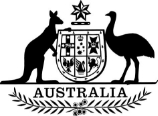Part 1—Preliminary
1 Name
This instrument is the Biosecurity (Biosecurity Response Zone for Foot and Mouth Disease—Relevant Ports) Determination 2022.
2 Commencement
(1) Each provision of this instrument specified in column 1 of the table commences, or is taken to have commenced, in accordance with column 2 of the table. Any other statement in column 2 has effect according to its terms.
Commencement information |
Column 1 | Column 2 | Column 3 |
Provisions | Commencement | Date/Details |
1. The whole of this instrument | 24 September 2022. | 24 September 2022 |
Note: This table relates only to the provisions of this instrument as originally made. It will not be amended to deal with any later amendments of this instrument.
(2) Any information in column 3 of the table is not part of this instrument. Information may be inserted in this column, or information in it may be edited, in any published version of this instrument.
3 Authority
This instrument is made under subsection 365(1) of the Biosecurity Act 2015.
4 Definitions
In this instrument:
Act means the Biosecurity Act 2015.
biosecurity response zone means an area specified in section 6.
relevant port means a port that is determined under subsection 229(1) of the Act to be a first point of entry for a vessel or class of vessels.
5 Reasons for making instrument
The reasons for making this instrument are that:
(a) a biosecurity officer suspects, on reasonable grounds, that:
(i) a disease or pest may be present in or on goods or premises in the biosecurity response zone; and
(ii) the disease or pest poses an unacceptable level of biosecurity risk; and
(b) the Director of Biosecurity is satisfied it is necessary to make this instrument for the purpose of managing the biosecurity risk posed by the disease or pest.
Note 1: See section 310 of the Act in relation to the meaning of biosecurity risk in Chapter 6 of the Act and this instrument.
Note 2: The matters included in this section must be stated in a biosecurity response zone determination: see subsection 366(1) of the Act.
Part 2—Biosecurity response zone
6 Biosecurity response zone
The following areas are a biosecurity response zone:
(a) each area of a relevant port that is designated, under paragraph 230(a) of the Act, as a biosecurity entry point for a vessel or class of vessels;
(b) the Port of Cocos (Keeling) Islands.
Note 1: The powers set out in Part 3 of this instrument and Division 4 of Part 3 of Chapter 6 of the Act may be exercised in, or in relation to goods or premises (which includes a conveyance) in, the biosecurity response zone for the purpose of managing the biosecurity risk posed by a disease or pest to which this instrument relates (see sections 370 and 371 of the Act).
Note 2: Before exercising a power set out in Part 3 of this instrument, a biosecurity official must be satisfied of the matters referred to in section 32 of the Act (the principles).
7 Diseases and pests
For the purposes of paragraph 366(2)(a) of the Act, foot and mouth disease poses an unacceptable level of biosecurity risk and has been identified.
8 Nature of biosecurity risk that needs to be managed
For the purposes of paragraph 366(2)(b) of the Act, the nature of the biosecurity risk that needs to be managed is that:
(a) there is a likelihood that foot and mouth disease may be present in or on goods in a biosecurity response zone, in particular on footwear worn by people entering Australia from a country with an active outbreak of foot and mouth disease; and
(b) foot and mouth disease is not present in Australia; and
(c) foot and mouth disease is a highly contagious viral disease of cloven‑hoofed mammals that has a great potential for causing severe economic loss if it enters Australia; and
(d) foot and mouth disease poses an unacceptable level of biosecurity risk.
Part 3—Powers that may be exercised in, or in relation to goods or premises in, the biosecurity response zone
9 Powers to require biosecurity measures to be taken
For the purposes of paragraph 366(2)(c) of the Act, the powers set out in the following sections of Division 2 of Part 3 of Chapter 6 of the Act are specified:
(a) section 333 (entry and exit etc. requirements—persons);
(b) section 335 (treatment of goods);
(c) section 336 (treatment that may damage goods).
10 Additional biosecurity response zone powers
For the purposes of paragraph 366(2)(f) of the Act, the powers set out in the following paragraphs of section 367 of the Act are specified:
(a) paragraph (a) (identification of the biosecurity response zone);
(b) paragraph (d) (setting traps or setting up equipment or other structures in the biosecurity response zone).
Part 4—Period in force
11 Period in force
For the purposes of paragraph 366(2)(g) of the Act, this instrument is in force for the period beginning on 24 September 2022 and ending on 30 June 2023.
12 Repeal
This instrument is repealed on 1 July 2023.
